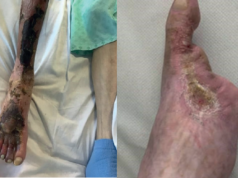
At the Charing Cross Symposium (London, UK), Ian Chetter (Hull, UK) presented on the pathway from assessment to treatment for patients with surgical wounds healing by second intention (SWHSI), discussing the impact this may have on such factors as quality of life. In this article on the work conducted by SWHSI and SWHSI-2 researchers, Chetter and Catherine Arundel (York, UK) explore the range of treatments available, comparing their efficacy and popularity with patients.
Over 10 million surgical operations occur within the NHS each year,¹ with associated surgical incisions usually closed with sutures or staples. However, it may not always be possible to close the wound and, even if it is, the wound might dehisce following closure. In such situations, the wound may be left open to heal by secondary intention – from the bottom up through the formation of granulation tissue.
SWHSI may require frequent dressing changes, with a range of options available from simple, non-adherent dressings to more expensive, complex treatments such as negative pressure wound therapy (NPWT). The management of these wounds can also be challenging given their prolonged healing trajectory and the potential need for extended hospitalisation or additional treatments.²
Despite the complexity of these wounds, and the extensive treatments required, there is a limited evidence base relating to patient and wound characteristics, healing rates and the effectiveness of treatments for SWHSI³. A recently completed NIHR-funded Programme Grant for Applied Research (reference: RP-PG-0609-10171) has resulted in a better understanding of the management of SWHSI through a range of research methods, including a cross-sectional survey, cohort study, econometric modelling, and a pilot, feasibility trial.
Cross-sectional survey data⁴ identified that SWHSI is a relatively common occurrence with an estimated prevalence of 4.1 per 10,000 population (95% CI: 3.5 to 4.7). Of the 187 participants included in the survey, SWHSI were frequently seen following colorectal (n=80, 42.8%), plastic (n=24, 12.8%) and vascular (n=22, 11.8%) surgeries, with the majority of these wounds being planned before surgery (n=90, 48.1%). Most patients received wound treatment (n=109, 58.3%), with the majority of patients receiving their wound care in community settings (n=109, 58.3%).⁴
To build on this evidence, a prospective cohort study³ was completed, producing data which concurred with the cross-sectional survey findings with regards to associated surgical specialty and the planning of SWHSI prior to operation. The cohort data also indicated that hydrofibre dressings (n=259, 65.9%) were the most common treatment, yet a number of patients (n=115, 29.3%) used the more complex NPWT. The cohort study also afforded identification of patient healing trajectories with healing occurring in 81.4% (n=320) of participants at a median of 86 days (95% CI: 75 to 103). Duration of healing was longer in patients with leg (median: 127; 95%CI: 92-210) days) or foot (median: 182; 95%CI: 150-231 days) wounds. Utilising the data collected, predictors of prolonged healing were identified: baseline wound area (p=<0.01), surgical wound contamination (determined during surgery) (p=0.04) and wound infection at any time (baseline or post-operatively) (p=<0.01).³
Using the cohort data, two econometric models (Model A – least ordinary least squares with imputation; Model B – two-stage model – logistic and linear regression) assessed the clinical and cost-effectiveness of NPWT as a treatment for SWHSI.⁵ NPWT was found to be less effective than standard dressing treatments for the healing of SWHSI; Model A – 73 days longer (than those who did not receive NPWT) (95% Credible Interval (CrI): 33.8 to 112.8); Model B – 46 days longer (95% CrI: 19.6 to 72.5). Using incremental quality-adjusted life years, NPWT was also found to be less cost-effective than standard dressing treatments; Model A: -0.012 (SE 0.005) (observables); -0.008 (SE 0.011) (unobservables); Model B: -0.007 (observables) and -0.027 (unobservables) (SE 0.017).⁵ It is important however to note that effectiveness estimates are derived from observational data and so confounding may reduce confidence in these findings.
Qualitative interviews with patients (n=20) identified initial shock and disbelief from patients experiencing a SWHSI.⁶ Quality of life was notably impaired for patients living with a SWHSI, especially those with dependents or in paid employment. For patients, wound healing was a key outcome, with a willingness to try any treatment that promised wound healing. Interviews with health professionals (n=12) identified that they had variable knowledge of SWHSI treatments, and frequently favoured NPWT despite the lack of robust evidence.⁶
As the final element of the NIHR-funded Programme Grant for Applied Research (RP-PG-0609-10171), a pilot, feasibility randomised controlled trial (RCT) was conducted.⁷,⁸ In total, 248 patients were screened for eligibility, with 40 participants (16%) subsequently recruited and randomised to receive NPWT or usual care (no NPWT). During the three-month follow up period, 10 (25%) wounds were determined to have healed. The pilot, feasibility RCT demonstrated that it would be possible to complete a full RCT to provide definitive evidence for the effectiveness of NPWT as a treatment for SWHSI.⁸
The NIHR Health Technology Assessment programme has subsequently funded (reference: 17/94/42) a pragmatic, multicentre RCT to assess the clinical and cost effectiveness of NPWT as a treatment for SWHSI, compared to standard dressings. This study will recruit 696 participants from across surgical specialities, and patients will be allocated 1:1 to receive either NPWT or usual care (standard dressings). The study will aim to ascertain the difference in time to wound healing (in days since randomisation) between the two study arms as the primary outcome. Secondary outcomes include significant clinical events, wound infection, wound pain, patient quality of life and healthcare resource use.
Professor Ian Chetter is an experienced vascular surgeon and chair of surgery at Hull York Medical School. He is a NIHR senior investigator, chairs the Research Committee of the Vascular Society of Great Britain & Ireland and is chief investigator for both the SWHSI Programme Grant for Applied Research and the SWHSI-2 randomised controlled trial.
Catherine Arundel is a trial methodologist based at York Trials Unit, University of York. She has extensive experience coordinating and managing large scale randomised controlled trials and associated research. This has included coordinating the SWHSI Programme Grant for Applied Research and currently the SWHSI-2 randomised controlled trial.
References:
- NHS Confederation. Key statistics on the NHS 2016 [Available from: http://www.nhsconfed.org/resources/key-statistics-on-the-nhs.
- Mees J, Mardin WA, Senninger N, Bruewer M, Palmes D, and Mees ST,. Treatment options for postoperatively infected abdominal wall wounds healing by secondary intention. Lagenbecks Arch Surg. 2012;397(8):1359-66.
- Chetter IC, Oswald AV, McGinnis E, Stubbs N, Arundel C, Buckley H, et al. Patients with surgical wounds healing by secondary intention: A prospective, cohort study. Int J Nurs Stud. 2019;89:62-71.
- Chetter IC, Oswald AV, Fletcher M, Dumville JC and Cullum NA. A survey of patients with surgical wounds healing by secondary intention; an assessment of prevalence, aetiology, duration and management. J Tissue Viability. 2016;26(2):103-7.
- Saramago P, Claxton K, Welton NJ, and Soares M,. Bayesian econometric modelling of observational data for cost-effectiveness analysis – Establishing the value of negative pressure wound therapy in the healing of open surgical wounds. Unpublished. 2019.
- McCaughan D, Sheard L, Dumville J, Cullum N, and Chetter IC,. Patients’ perceptions and experiences of living with a surgical wound healing by secondary intention: A qualitative study. Int J Nurs Stud. 2018;77:29-38.
- Arundel C, Buckey H, Clarke E, Cullum N, Dixon S, Dumville J, et al. Surgical Wounds Healing by Secondary Intention (SWHSI): study protocol for a randomised controlled pilot trial comparing negative pressure wound therapy versus usual care. . Trials. 2016;17(535).
- Arundel C, Fairhurst C, Corbacho-Martin B, Buckley H, Clarke E, Cullum N, et al. Pilot feasibility randomized clinical trial of negative‐pressure wound therapy versus usual care in patients with surgical wounds healing by secondary intention. BJS Open. 2018;2(3):99-111.
Acknowledgements:
- The SWHSI project was funded by the National Institute for Health Research (NIHR) Programme Grant for Applied Research (Reference: RP-PG-0609-10171).
- The SWHSI-2 Trial is funded by the National Institute for Health Research (NIHR) Health Technology Assessment Programme (Reference: 17/42/94).
- The views expressed are those of the author(s) and not necessarily those of the NIHR or the Department of Health and Social Care.













